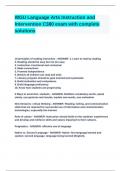WGU Language Arts Instruction and
Intervention C380 exam with complete
solutions
10 principles of reading instruction - ANSWER- 1. Learn to read by reading
2. Reading should be easy but not too easy
3. Instruction- Functional and contextual
4. Make connections
5. Promote independence
6. Believe all children can read and write
7. Literacy program should be goal oriented and systematic
8. Build motivation and competence
9. Build language proficiency
10. Know how students are progressing
5 Ways to assist ELL students - ANSWER- Boldface vocabulary words, speak
slowly, use gestures and visuals, explain new words, use motivation.
New literacies- critical thinking - ANSWER- Reading, writing, and communication
skills that are required for successful use of information and communication
technologies, especially the Internet.
Role of culture - ANSWER- Instruction should build on the students' experiences
and develop and reinforce skills and values important to their cultures.
Pragmatics - ANSWER- effective use of language
Native vs. Second Language - ANSWER- Native- first language learned and
spoken; second language- language being learned (English).
, Ways to Support ELL with no Bilingual Program - ANSWER- Language experience
stories, predictable books, writing, oral language skills
15 Ways to support all ELL students - ANSWER- secure environment, build
language, modeling, running commentary, expansion, redirect, academic
language, academic word lists, sentence starters, word walls, checking for
understanding, empowering, cooperative groups, peer tutoring, use of print.
6 Strategies for Economically Disadvantaged Students - ANSWER- build
background, emphasize success, make instruction explicit, provide a balanced
program, provide access to books and magazines, and counteract fourth-grade
slump
Learning Disabilities - ANSWER- can generally be considered to be caused by a
weakness in information processing such as visual-perceptual skills, auditory
processing, language skills, and attention and motor skills.
16 Strategies for ADD - ANSWER- provide meaningful and interesting tasks, give
choices, allow mobility in the classroom, allow students to work together,
minimize formal tests, make sure they understand directions, make sure they
have all needed materials, keep a schedule, use visual aids, schedule breaks,
work with parents, minimize distractions, have clear procedures, highlight
important information, use peer tutoring, use computers.
3 Strategies for Intellectual Disabilities - ANSWER- use modeling, stay on task,
determine relevant information.
5 Strategies for Slow Learners - ANSWER- use concrete examples, give guidance,
more practice, more time on learning tasks, use materials on their level.
Language and Speech Support - ANSWER- Help child apply skills in the
classroom that are learned while working with a speech therapist.
Modifications - ANSWER- Change in content or structure of instruction (like
altering the curriculum).
Accommodations - ANSWER- Changes in the way student is taught- changes in
instruction, assessment, or the assignment of homework.
3 Strategies for Gifted Students - ANSWER- materials on their instructional level,
use reading and writing workshops, self selected texts.




